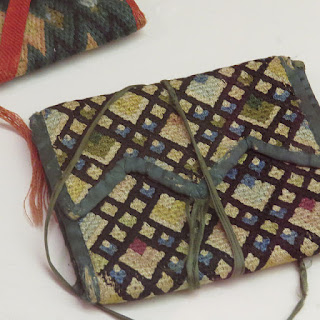When working on projects inspired by or meant to recreate historic pieces, we are often faced by a number of problems with fabric selection.
First, descriptions in books and museum websites are not always using words the same way we use them. For instance, does a description of an item as being on "linen canvas" mean that it was a linen ground with a fairly open weave, similar to today's "needlepoint canvas?" That's certainly what comes to my mind, but without seeing the piece in person, or really really good photographs, including areas that the threads may have worn away, I can't be sure.
Second, there may simply not be a fabric similar to the one originally used.
Third, time, use, and the manner of storage over the years may have changed the original fabric so that when we study the piece, we are not seeing what was originally worked on, but what that fabric has become.
Still, often we can come close, and when we can't we can make adjustments.
The project that raised this topic is one of Richard Wymarc's charting of German Brick Stitch. The particular design that was referenced calls for "37 count" fabric. Unfortunately, there is no 37 count fabric, and the question went out of what to use.
Here are the factors I would be considering if I were doing this project.
1. Hand. "Hand" is the the sort of short hand word needle workers use for how the fabric feels in the hand. Is it drapey or stiff. Will it work well for stitching without a hoop or frame? Will it stand up to being stretched tightly? Will it hold up to being covered with thread, or will it prefer being only partially embroidered? Does the fabric drape more like clothing or table linens, or does it feel like it will be good for a cushion? Two fabrics, both 100% linen and at the same thread count may have very different "hand." For the given project I would prefer a fabric with a fairly stiff hand so that it will stand up to the high tension and large amount of thread (the ground fabric is covered in this form) it will be supporting.
2. Hole size. Some fabrics are made up up plumper threads while others have thinner or more tightly spun threads. This will make a difference to the size of the holes. Two fabrics, both 100% linen and at the same thread count may have different hole size. At higher thread counts, it may become too hard to see individual threads and holes, ruling out a counted form of embroidery (and that threshold will vary by embroiderer), yet another fabric at the same high count but with tighter threads, the individual holes may still be visible and countable. For this project I would look for a fabric with a large hole-to-thread ratio. I have often described "canvas embroidery" as where the holes are larger than the threads making up the fabric. This will be easy to count.
 |
| Two fabrics, close in thread count, but because of the character of the threads, the holes appear different. (Note that these are not both linen, the congress cloth shown here is cotton |
3. Appearance. Most linen fabrics today are available in natural and eggshell as well as white. I tend to go for one in the natural range. This is possibly personal preference.
4. Fiber. Yes, linen is often the ground cloth of the original, and when it is, linen is the first choice. However, if the hand, hole size and appearance of a cotton "needlepoint" canvas answer the project well, I would go with the cotton. For example, I have been fortunate enough to do two pieces in German Brick Work on linen Congress Cloth (24 count). However, this fabric is no longer being made. Congress Cloth is still made, in cotton, and the eggshell is very close in color to the linen. I would count this an acceptable substitute, the Congress Cloth being in all other ways an admirable stand in for the original fabric.
The website Needle In a Haystack has a nice informational page about embroidery fabrics that makes a good guide: http://www.needlestack.com/fabric.html. Their industry fabric guide (PDF) is from 2011 and it is possible that some of the fabrics listed are not available, but it makes a good jumping off point.
My final choice for the given project? First I would go through my stash, checking the thread count of the fabrics I don't have marked. If I failed to find something there to suit, I would probably go with the Wichelt 35 count linen. From Needle In a Haystack's description it has the stiffer hand that I would prefer for this project.
At one time I had assembled a book with samples of many embroidery fabrics and notes of their characteristics and where they were available. Sadly, that appears to have been discarded. Time to assemble a new one -- a blog post to come perhaps?


























